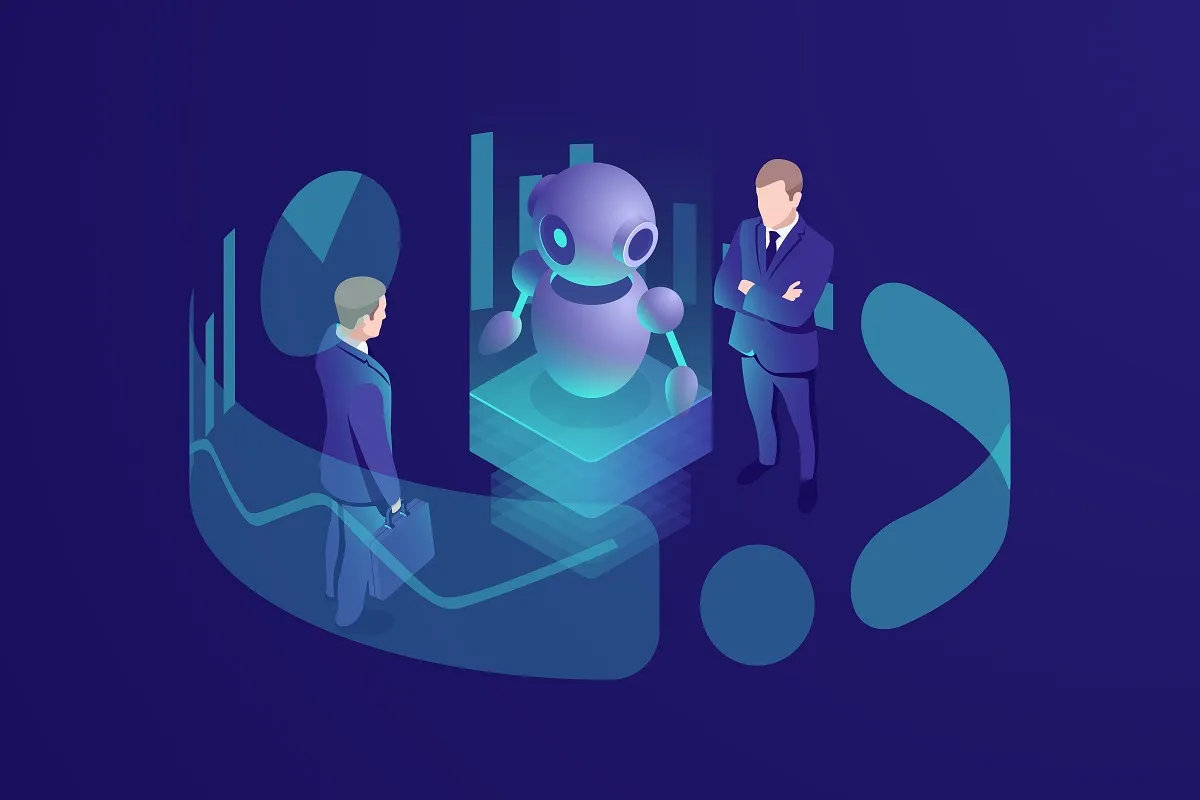A chatbot is like a virtual assistant on websites, apps, or messaging platforms. They’re computer programs that “chat” or interact with users, often using friendly and casual language. Think of them as the helpful staff you chat with on websites when you have questions.
There are a few big reasons why chatbots are taking off:
Instant responses: In our fast-paced world, waiting is frustrating. Chatbots give answers immediately, day or night.
Available 24/7: Unlike human staff who need breaks, chatbots are always ready to help, any hour of the day.
Cost-effective: For businesses, chatbots save money. Instead of hiring more staff, a chatbot can handle multiple queries at once.
Tech evolution: With advancements in artificial intelligence (AI) and technology, chatbots are getting smarter, understanding user queries better and providing more accurate responses.
Modern businesses thrive on efficiency, customer satisfaction, and innovation. Chatbots offer all these and more:
Improved Customer Service: With chatbots, users get immediate answers to their questions.
Streamlined Operations: Businesses can automate tasks like answering FAQs or booking appointments.
Data Collection: Chatbots interact with numerous customers daily, collecting valuable feedback and data which businesses can use to improve.
Sales and Marketing: Some advanced chatbots can even recommend products or services, turning interactions into sales opportunities.
Impact on Business
How can chatbots improve customer service?
At the heart of excellent customer service is timely assistance. Chatbots, as virtual assistants, ensure that customers receive immediate answers to their queries. This real-time response keeps customers satisfied, ensuring they don’t leave a website or app out of frustration.
The internet never sleeps, and neither do chatbots. Whether it’s day or night, holidays or weekends, chatbots are always available to assist users. This continuous availability boosts customer trust and satisfaction.
Human customer representatives can have off days or might provide varied information. Chatbots, on the other hand, offer consistent, error-free responses every time.
How can chatbots streamline business processes?
Many businesses face the burden of repeated queries or actions. Chatbots can efficiently manage tasks like bookings, order status checks, or answering frequently asked questions, reducing the manual workload.
A human can handle one conversation at a time. Chatbots can manage multiple interactions simultaneously, allowing businesses to scale their operations without proportional increases in staff.
Implementing a chatbot can be more cost-effective in the long run than hiring additional staff, especially for businesses with high customer interaction volumes.
How can chatbots provide deep consumer insights?
Every interaction with a chatbot is a data point. These virtual assistants can collect and store information from user queries, giving businesses a clearer picture of their customers’ needs, preferences, and pain points.
Over time, the data gathered by chatbots can highlight patterns. For instance, if multiple users ask similar questions or show interest in a particular product or service, businesses can identify these trends and adapt accordingly.
The AI Advantage: Improve Your Business Performance with AI Development
With the insights gained from chatbot interactions, businesses can tailor their marketing strategies, product recommendations, and content to better align with what their audience wants.
Business Benefits Drive the Adoption of Bot Solutions
Cost Savings
Implementing chatbots can significantly reduce expenses for businesses. Instead of hiring more staff for customer support, a well-programmed chatbot can handle numerous queries, especially the repetitive ones, at a fraction of the cost.
As your business grows, so does the number of customer queries. Chatbots allow enterprises to handle increased interaction volume without necessarily hiring more personnel, resulting in considerable long-term savings.
Increased Efficiency
Time is money. Chatbots provide instant replies, ensuring that customers receive timely answers, which can make operations run more smoothly and effectively.
Unlike humans, chatbots can manage multiple conversations at once. This capability means faster service and less waiting time for users.
Humans can make mistakes, especially when overloaded with queries. Chatbots offer consistent and accurate responses, reducing the risk of errors and misinformation.
Improved Customer Satisfaction
Consumers today expect round-the-clock support. With chatbots, businesses can offer non-stop assistance, ensuring that customers’ questions are addressed even outside typical business hours.
Advanced chatbots can remember past interactions, providing customers with personalized experiences based on their history and preferences, enhancing overall satisfaction.
Enhanced Data Insights
Every chatbot interaction offers valuable data. By tracking these conversations, businesses can gather insights into what customers are asking, what issues they’re facing, and what they’re interested in.
The information collected by chatbots can be analyzed to make informed decisions. Whether it’s refining a product, tweaking a marketing strategy, or enhancing user experience, data insights offer a roadmap for improvements.
Analyzing chatbot interactions can help businesses identify emerging trends. If many users ask about a particular product feature, for instance, it signals a potential area of interest or concern that businesses can address proactively.
Enhanced Customer Experience
24/7 Availability
In today’s digital age, customers are online around the clock. Chatbots ensure that businesses are always ready to help, no matter the hour. This 24/7 availability means users don’t have to wait for opening hours to get answers, leading to enhanced customer satisfaction.
Unlike traditional helplines where users might be placed on hold, chatbots provide immediate responses. This constant accessibility ensures customers feel valued and attended to anytime they interact with a business.
Personalized Service
Imagine walking into your favorite cafe, and the barista remembers your usual order. That’s what chatbots can do online. By recalling past interactions and preferences, chatbots can offer personalized recommendations and services, making users feel special and understood.
With the data they gather, chatbots can suggest products or solutions that align with a user’s interests and needs, elevating the user experience.
Self-service Options
Many customers prefer finding solutions on their own rather than waiting for assistance. Chatbots provide self-service options, allowing users to resolve issues, access information, or complete tasks autonomously.
Through easy-to-navigate menus and intuitive interfaces, chatbots guide users towards the answers they seek, ensuring they achieve their goals without confusion or frustration.
Increased Customer Engagement
Unlike static FAQs, chatbots offer dynamic conversations. This interactive nature keeps users engaged, making them more likely to explore further and connect with the brand.
Many chatbots solicit feedback after interactions, giving users a voice in their experience. This engagement ensures customers feel heard and valued, fostering a stronger connection to the business.
Streamlining Business Processes with Robot-based Automation
The power of robot-based automation in the modern business landscape cannot be overstated.
By automating repetitive tasks, enhancing accuracy, and liberating human resources for strategic endeavors, companies can optimize their operations, ensuring they remain agile, efficient, and competitive in an ever-evolving market. Investing in automation today is a step towards building a robust and resilient business for tomorrow.
Automate Repetitive Tasks
Every business has tasks that are repetitive and time-consuming. Robot-based automation, often referred to as chatbots or robotic process automation (RPA), can take on these tasks.
This means processes like data entry, appointment scheduling, or answering frequently asked questions can be automated, ensuring they’re done swiftly and consistently.
Automation ensures that the same task is performed the same way every time. This uniformity guarantees that customers and stakeholders experience a consistent brand interaction, elevating their trust and satisfaction.
Improve Accuracy and Efficiency
Human error is a natural part of manual tasks, especially when they’re repetitive.
Robot-based automation, however, operates based on the programming and algorithms set for it. This means fewer mistakes and more accurate results, whether it’s processing an order or responding to an inquiry.
Automated systems, being machine-driven, can perform tasks at a much faster rate than humans. This swiftness ensures that business operations are efficient, meeting customer demands in record time.
Free Up Human Resources for More Strategic Tasks
With automation handling repetitive tasks, human resources are freed up to focus on more complex, value-added activities. Whether it’s strategic planning, relationship building, or creative endeavors, employees can channel their energies where human intellect truly shines.
When employees are relieved from mundane tasks and can focus on areas where they can make a genuine impact, job satisfaction often increases. A motivated workforce is not only more productive but also drives innovation and growth.
Providing Deep Consumer Insights
Collect Data on Customer Preferences and Behavior
Every interaction a customer has online leaves behind data. Whether they’re clicking on a product, asking a question, or just browsing, these actions provide valuable insights.
Tools, especially chatbots, collect this data, giving businesses a detailed look into what customers like, need, and expect.
Collecting data on user behavior and preferences allows businesses to build a clearer profile of their target audience. This understanding ensures that marketing campaigns, product launches, and other business strategies are more aligned with what the audience truly wants.
Identify Trends and Patterns
By analyzing the vast amount of data collected, businesses can identify emerging trends. Whether it’s a sudden interest in a particular product type or a recurring question among customers, these patterns offer businesses a heads-up on market movements.
Recognizing trends early on gives businesses a competitive edge. They can adapt faster, innovate based on the patterns observed, and position themselves as market leaders, always staying one step ahead of the curve.
Improve Product and Service Offerings
The data and trends identified aren’t just for observation; they’re actionable insights. If customers frequently inquire about a feature that a product lacks, there’s a clear sign that the feature is in demand.
Businesses can then refine their products or services based on this feedback.
With a deep understanding of customer behavior and preferences, companies can tailor their offerings to better suit their audience.
This could mean launching new products, tweaking existing ones, or even introducing new services that cater to the identified needs.
Chatbot Development
While chatbot development offers a promising avenue for businesses to engage with their users in a modern way, it’s a journey that comes with its challenges.
But with the right approach, strategy, and tools, the rewards in enhanced user experience and operational efficiency can be significant. As the digital landscape evolves, chatbots are proving to be game-changers in redefining how businesses interact with their audience.
The Different Types of Chatbots
These are the most basic form of chatbots. They operate based on a predefined set of rules. Users interact with them through specific commands, and the bot provides responses based on those rules. They are great for specific tasks but lack the flexibility to handle unexpected queries.
These are the advanced players in the chatbot game. Using machine learning and artificial intelligence, these chatbots can learn from user interactions. They’re more dynamic, can understand natural language, and can offer more personalized responses based on the data they accumulate.
A combination of rule-based and AI-powered systems, hybrid chatbots are designed to leverage the strengths of both types. They provide consistent answers for known queries and can also handle unexpected questions using AI.
The Steps Involved in Chatbot Development
Like any development project, building a chatbot starts with understanding the requirements. What is the primary function of the chatbot? Who is the target audience? Answering these questions will set the foundation.
Based on requirements, developers decide whether a rule-based, AI-powered, or hybrid chatbot is the best fit.
This phase involves crafting the user interface, setting up conversation flows, and integrating the necessary technologies.
Especially crucial for AI-powered chatbots, this step involves feeding the bot data, letting it learn, and refining its responses.
Once the chatbot is ready, it’s integrated into the desired platform, be it a website, messaging app, or any other digital channel.
Post-deployment, it’s essential to gather user feedback and make iterative improvements to enhance the chatbot’s efficiency and accuracy.
The Challenges of Chatbot Development
One of the primary challenges in chatbot development is ensuring that the bot understands the nuances of human language, including slang, local dialects, and emotions.
With chatbots collecting user data, ensuring this data is stored securely and ethically is paramount.
AI-powered chatbots require continuous training to improve. This ongoing commitment can be resource-intensive.
The Future of AI Writing Tools: What to Expect in 2023 and Beyond
Users today expect chatbots to be highly efficient, almost human-like in their interactions. Meeting these expectations can be challenging, especially with rapidly evolving tech standards.
Conclusion
Modern users demand immediate attention, and chatbots, with their 24/7 availability, are perfectly equipped to meet this demand. They usher in an era where customer service is swift, efficient, and remarkably consistent.
Enterprises thrive on data, and chatbots serve as efficient data collectors. By continuously interacting with users, they gather valuable insights into consumer behavior, preferences, and expectations.
This goldmine of information equips businesses to make informed, user-centric decisions, ensuring they remain in tune with market demands.
Beyond customer interactions, the role of chatbots in streamlining various business processes can’t be overstated.
From automating repetitive tasks to providing instant internal support, chatbots are proving to be valuable assets in optimizing operations and freeing up human resources for more strategic initiatives.
As AI and machine learning technologies continue to mature, the capabilities of chatbots will expand further.
We’re on the brink of witnessing chatbots that can not only understand and respond to complex queries but can also predict user needs, offer proactive solutions, and engage users in more human-like interactions.
For enterprises, this signifies a shift towards more personalized, efficient, and data-driven operations.
In wrapping up, the future of chatbots in the enterprise world is not just promising; it’s transformative
They represent a convergence of technology and human-centric service, heralding a future where businesses can operate with unparalleled efficiency while offering a user experience that’s richer and more personalized than ever before.
Investing in chatbot development today is an investment in a smarter, more responsive future for enterprises.



